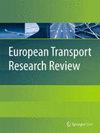Inference of dynamic origin–destination matrices with trip and transfer status from individual smart card data
IF 4.2
3区 工程技术
Q1 TRANSPORTATION
引用次数: 9
Abstract
The provision of seamless public transport supply requires a complete understanding of the real traffic dynamics, comprising origin-to-destination multimodal mobility patterns along the transport network. However, most current solutions are centred on the volumetric analysis of passengers’ flows, generally neglecting transfer, walking, and waiting needs, as well as the changes in the mobility patterns with the calendar and user profile. These challenges prevent a comprehensive assessment of the routing and scheduling vulnerabilities of (multimodal) public transport networks. The research presented in this paper aims at addressing the above challenges by proposing a novel approach that extends dynamic Origin-Destination (OD) matrix inference to dynamic OD matrix inference with aggregated statistics, highlighting vulnerabilities and multimodal mobility patterns from individual trip record data. Given specific spatial and temporal criteria, the proposed methodology extends dynamic Origin-Destination (OD) matrices with aggregated statistics, using smart-card validations gathered from (multimodal) public transport networks. More specifically, three major contributions are tackled; i) the data enrichment in the OD matrices with statistical information besides trip volume (e.g., transfer and trip features); ii) the detection of vulnerabilities on the network pertaining to walking distances and trip durations in a user-centric way and iii) the decomposition of traffic flows in accordance with calendrical rules and user (passenger) profiles. The set of contributions are validated on the bus-and-metro public transport network in the city of Lisbon. The proposed approach for inferring OD matrices yields four unique contributions. First, we allow inference to consider multimodal commuting patterns, detecting individual trips undertaken along with different operators. Second, we support dynamic matrices’ OD inference along with parameterizable time intervals and calendrical rules, and further support the decomposition of traffic flows according to the user profile. Third, we allow parameterization of the desirable spatial granularity and visualisation preferences. Fourth, our solution efficiently computes several statistics that support OD matrix analysis, helping with the detection of vulnerabilities throughout the transport network. More specifically, statistical indicators related to travellers’ functional mobility needs (commuters for working purposes, etc.), walking distances and trip durations are supported. The inferred dynamic OD matrices are the outcome of a developed software with strict guarantees of usability. Results from the case study using data gathered from the two main public transport operators (Bus and Metro) in the city of Lisbon show that 77.3% of alighting stops can be estimated with a high confidence degree from bus smart-card data. The inferred OD matrices (Bus and Metro) in the city of Lisbon reveal vulnerabilities along specific OD pairs, offering the bus public operators in Lisbon new knowledge and a means to better understand dynamics and validate OD assumptions.基于智能卡个人数据的动态起点-目的地矩阵的行程和传输状态推断
提供无缝的公共交通供应需要完全了解真实的交通动态,包括交通网络中从起点到目的地的多式联运模式。然而,目前的大多数解决方案都集中在对乘客流量的体积分析上,通常忽略了换乘、步行和等待需求,以及随日历和用户资料而变化的移动模式。这些挑战阻碍了对(多式联运)公共交通网络的路由和调度漏洞的全面评估。本文的研究旨在通过提出一种新的方法来解决上述挑战,该方法将动态始发-目的地(OD)矩阵推理扩展到具有聚合统计的动态OD矩阵推理,突出了个体旅行记录数据的脆弱性和多模式移动模式。给定特定的空间和时间标准,建议的方法扩展动态起点-目的地(OD)矩阵与汇总统计,使用从(多式联运)公共交通网络收集的智能卡验证。更具体地说,解决了三个主要贡献;i)在OD矩阵中加入除行程量以外的统计信息(例如,转移和行程特征)来丰富数据;Ii)以用户为中心的方式检测网络上与步行距离和行程持续时间有关的漏洞;iii)根据日历规则和用户(乘客)配置文件分解交通流。这组贡献在里斯本市的公共汽车和地铁公共交通网络上得到了验证。所提出的推断OD矩阵的方法有四个独特的贡献。首先,我们允许推理考虑多模式通勤模式,检测与不同运营商一起进行的个人旅行。其次,我们支持动态矩阵的OD推断以及可参数化的时间间隔和日历规则,并进一步支持根据用户配置文件分解交通流。第三,我们允许对理想的空间粒度和可视化偏好进行参数化。第四,我们的解决方案有效地计算了几种支持OD矩阵分析的统计数据,帮助检测整个传输网络中的漏洞。更具体地说,支持与旅行者的功能移动需求(工作目的的通勤者等)、步行距离和行程持续时间有关的统计指标。推导出的动态OD矩阵是在严格保证可用性的情况下开发的软件的结果。案例研究使用了里斯本市两家主要公共交通运营商(公共汽车和地铁)收集的数据,结果表明,77.3%的下车站点可以从公共汽车智能卡数据中获得高置信度。里斯本市推断的OD矩阵(公交和地铁)揭示了特定OD对的漏洞,为里斯本的公交公共运营商提供了新的知识和方法,以更好地理解动态和验证OD假设。
本文章由计算机程序翻译,如有差异,请以英文原文为准。
求助全文
约1分钟内获得全文
求助全文
来源期刊

European Transport Research Review
Engineering-Mechanical Engineering
CiteScore
8.60
自引率
4.70%
发文量
49
审稿时长
13 weeks
期刊介绍:
European Transport Research Review (ETRR) is a peer-reviewed open access journal publishing original high-quality scholarly research and developments in areas related to transportation science, technologies, policy and practice. Established in 2008 by the European Conference of Transport Research Institutes (ECTRI), the Journal provides researchers and practitioners around the world with an authoritative forum for the dissemination and critical discussion of new ideas and methodologies that originate in, or are of special interest to, the European transport research community. The journal is unique in its field, as it covers all modes of transport and addresses both the engineering and the social science perspective, offering a truly multidisciplinary platform for researchers, practitioners, engineers and policymakers. ETRR is aimed at a readership including researchers, practitioners in the design and operation of transportation systems, and policymakers at the international, national, regional and local levels.
 求助内容:
求助内容: 应助结果提醒方式:
应助结果提醒方式:


